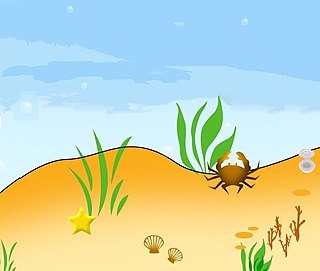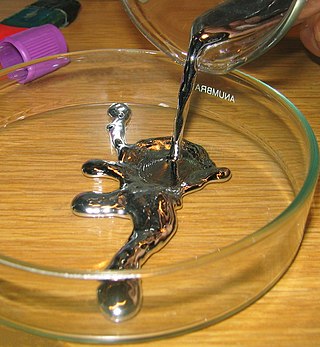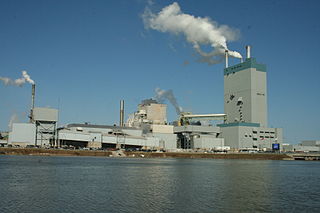
Water pollution is the contamination of water bodies, with a negative impact on their uses. It is usually a result of human activities. Water bodies include lakes, rivers, oceans, aquifers, reservoirs and groundwater. Water pollution results when contaminants mix with these water bodies. Contaminants can come from one of four main sources. These are sewage discharges, industrial activities, agricultural activities, and urban runoff including stormwater. Water pollution may affect either surface water or groundwater. This form of pollution can lead to many problems. One is the degradation of aquatic ecosystems. Another is spreading water-borne diseases when people use polluted water for drinking or irrigation. Water pollution also reduces the ecosystem services such as drinking water provided by the water resource.

Minamata is a city located in Kumamoto Prefecture, Japan. It is on the west coast of Kyūshū and faces Amakusa islands. Minamata was established as a village in 1889, re-designated as a town in 1912 and grew into a city in 1949. As of March 2017, the city has an estimated population of 25,310 and a population density of 160 persons per km2. The total area is 162.88 km2.

Methylmercury (sometimes methyl mercury) is an organometallic cation with the formula [CH3Hg]+. It is the simplest organomercury compound. Methylmercury is extremely toxic, and its derivatives are the major source of organic mercury for humans. It is a bioaccumulative environmental toxicant with a 50-day half-life. Methylmercury is the causative agent of the infamous Minamata disease.
The four big pollution diseases of Japan were a group of man-made diseases all caused by environmental pollution due to improper handling of industrial wastes by Japanese corporations. The first occurred in 1912, and the other three occurred in the 1950s and 1960s.

Mercury(II) sulfate, commonly called mercuric sulfate, is the chemical compound HgSO4. It is an odorless salt that forms white granules or crystalline powder. In water, it separates into an insoluble basic sulfate with a yellow color and sulfuric acid.

Macrobenthos consists of the organisms that live at the bottom of a water column and are visible to the naked eye. In some classification schemes, these organisms are larger than 1 mm; in another, the smallest dimension must be at least 0.5 mm. They include polychaete worms, pelecypods, anthozoans, echinoderms, sponges, ascidians, crustaceans.

Mercury is a chemical element; it has symbol Hg and atomic number 80. It is also known as quicksilver and was formerly named hydrargyrum from the Greek words hydor'water' and argyros'silver', from which its chemical symbol is derived. A heavy, silvery d-block element, mercury is the only metallic element that is known to be liquid at standard temperature and pressure; the only other element that is liquid under these conditions is the halogen bromine, though metals such as caesium, gallium, and rubidium melt just above room temperature.

The presence of mercury in fish is a health concern for people who eat them, especially for women who are or may become pregnant, nursing mothers, and young children. Fish and shellfish concentrate mercury in their bodies, often in the form of methylmercury, a highly toxic organomercury compound. This element is known to bioaccumulate in humans, so bioaccumulation in seafood carries over into human populations, where it can result in mercury poisoning. Mercury is dangerous to both natural ecosystems and humans because it is a metal known to be highly toxic, especially due to its neurotoxic ability to damage the central nervous system.

The mercury cycle is a biogeochemical cycle influenced by natural and anthropogenic processes that transform mercury through multiple chemical forms and environments.

Mercury regulation in the United States limit the maximum concentrations of mercury (Hg) that is permitted in air, water, soil, food and drugs. The regulations are promulgated by agencies such as the Environmental Protection Agency (EPA) and Food and Drug Administration (FDA), as well as a variety of state and local authorities. EPA published the Mercury and Air Toxics Standards (MATS) regulation in 2012; the first federal standards requiring power plants to limit emissions of mercury and other toxic gases.
Persistent, bioaccumulative and toxic substances (PBTs) are a class of compounds that have high resistance to degradation from abiotic and biotic factors, high mobility in the environment and high toxicity. Because of these factors PBTs have been observed to have a high order of bioaccumulation and biomagnification, very long retention times in various media, and widespread distribution across the globe. Most PBTs in the environment are either created through industry or are unintentional byproducts.

The Minamata Convention on Mercury is an international treaty designed to protect human health and the environment from anthropogenic emissions and releases of mercury and mercury compounds. The convention was a result of three years of meeting and negotiating, after which the text of the convention was approved by delegates representing close to 140 countries on 19 January 2013 in Geneva and adopted and signed later that year on 10 October 2013 at a diplomatic conference held in Kumamoto, Japan. The convention is named after the Japanese city Minamata. This naming is of symbolic importance as the city went through a devastating incident of mercury poisoning. It is expected that over the next few decades, this international agreement will enhance the reduction of mercury pollution from the targeted activities responsible for the major release of mercury to the immediate environment.
Mercury contamination in California waterways poses a threat to both the environment and human health. This naturally occurring heavy metal may be released into the environment from natural geological sources, but most commonly occurs from anthropogenic mining operations. This metal poses a threat not only for its effects on organisms, but also for difficulty of removal from waterways and the trouble in efficiently detecting it. The roots of mercury poisoning in waterways began with the historic mining of gold within California's streambed and hillsides; since the California Gold Rush, mercury has been used for gold extraction for its ability as a catalyze with the precious metal. due to the process of extraction and washing, mercury used would either be burned away as a hazardous vapor, or washed away into waterflows, resulting in widespread contamination of river and lake sediments. mercury continues to be released today through anthropogenic sources, though state and federal agencies work to manage and ban these practices and to mitigate its effect on the environmental and on people. Many water bodies in the state of California bear fish consumption advisories due to mercury content.
Parthasarathi Chakraborty is an Indian environmental geochemist, a former senior scientist at the CSIR-National Institute of Oceanography and an associate professor at the Indian Institute of Technology Kharagpur, India. Chakraborty is known for his studies in the field of Environmental Chemistry. He made contributions to the field of Environmental Geochemistry which has facilitated our understanding of the metals-natural ligands interactions in natural and marine environments. He is a recipient of the National Geoscience Award-2015 and an elected fellow of the Indian Geophysical Union.The Council of Scientific and Industrial Research, the apex agency of the Government of India for scientific research, awarded him the Shanti Swarup Bhatnagar Prize for Science and Technology, one of the highest Indian science awards, for his contributions to Earth, Atmosphere, Ocean and Planetary Sciences in 2018.
Mercury methylation is the process of forming methylmercury (MeHg). The methylation of mercury can occur abiotically or biotically. Biotically, the primary methylators of mercury are sulfate-reducing and iron-reducing bacteria. Three mechanisms have been proposed for the biotic methylation of mercury by sulfate-reducing bacteria. Mercury methylation can be problematic as methylmercury is toxic and can be bio-magnified through the food web.
Mercury is a poisonous element found in various forms in Canada. It can be emitted in the atmosphere naturally and anthropogenically, the main cause of mercury emission in the environment. Mercury pollution has become a sensitive issue in Canada for the past few decades and many steps have been taken for prevention at local, national, and international levels. It has been found to have various negative health and environmental effects. Methylmercury is the most toxic form of mercury which is easily accessible as well as digestible by living organisms and it is this form of mercury causing serious harm to human and wildlife health.

The boron cycle is the biogeochemical cycle of boron through the atmosphere, lithosphere, biosphere, and hydrosphere.

The lead cycle is the biogeochemical cycle of lead through the atmosphere, lithosphere, biosphere, and hydrosphere, which has been influenced by anthropogenic activities.

Mercury contamination in Grassy Narrows was an uncontrolled discharge of between 9,000 kilograms (20,000 lb) and 11,000 kilograms (24,000 lb) of mercury from the Dryden Mill's chloralkali plant in Dryden into the headwaters of the Wabigoon River in the Kenora District of Northwestern Ontario from 1962 until 1970. It was described as "one of the worst cases of environmental poisoning in Canadian history." The contamination poisoned many people in the Grassy Narrows First Nation and Whitedog First Nation communities.

The manganese cycle is the biogeochemical cycle of manganese through the atmosphere, hydrosphere, biosphere and lithosphere. There are bacteria that oxidise manganese to insoluble oxides, and others that reduce it to Mn2+ in order to use it.


















